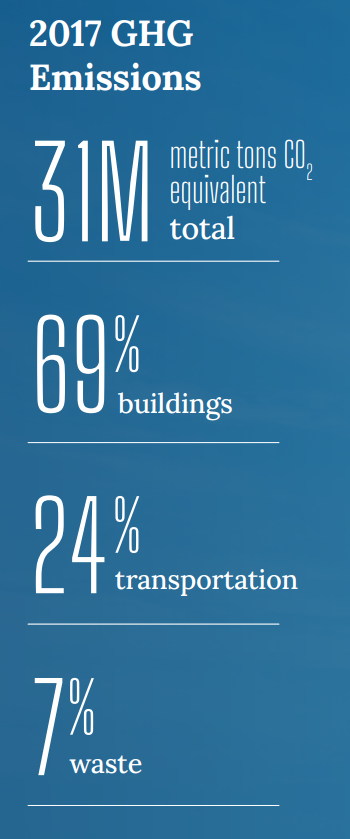Electrify Chicago
An independent tool for viewing City of Chicago building data
According to the
2022 Chicago Climate Action Plan,
69% of Chicago's emissions come from buildings, making
building emissions our biggest challenge and our biggest opportunity as a city
to tackle climate change. At Electrify Chicago, we showcase building performance using
publicly available data supplemented by community-submitted photographs and building
owners.
Start by looking at Chicago's buildings with the highest greenhouse gas intensity i.e. emissions per square foot. Large, efficient, buildings can perform much better than very inefficient small buildings on this metric.
New Article
📰 $30 Million In Missed Fines
The City Of Chicago failed to collect $30 million in potential fines from the building benchmarking ordinance, reducing transparency and accountability.
Legislative update! 🎉
As of late January 2024, legislation is being introduced to require new use more efficient forms of water and space heating, via the Clean And Affordable Buildings Ordinance (CABO), which will reduce the number of highly polluting and inefficient buildings that end up on this site.
If you're in Chicago,
write to your alderman to support the CABO!
Chicago Buildings by Greenhouse Gas Intensity
Note: Data includes large Chicago buildings with data from 2022, unless explicitly stated otherwise.
Note: This data only includes buildings whose emissions are reported
under the
Chicago Energy Benchmarking Ordinance. According to the City “As of 2016,
this list includes all commercial, institutional, and residential buildings larger than
50,000 square feet.” This dataset is also then filtered to only buildings with
reported emissions > 1,000 metric tons CO2 equivalent.
The latest year of data is from 2022, but we update the site regularly when new data is available, and some buildings may have failed to report that year, and only have older data available.
| Property Name / address | Primary Property Type |
Greenhouse Gas Intensity (kg CO2 eq./sqft) |
Total Greenhouse Emissions (metric tons CO2 eq.) |
|---|---|---|---|
|
Elston & Logan Commercial Development
🕰️
2705-2749 N. Elston
| Strip Mall | 6.0 kg/sqft | 338 tons |
|
The Bostonian
4278 N HAZEL ST
| Multifamily Housing | 6.0 kg/sqft
Lowest 42%
| 286 tons
Lowest 7%
|
|
829 S WABASH AVE
🕰️
829 S WABASH AVE
| Multifamily Housing | 6.0 kg/sqft | 954 tons |
|
1300 N STATE PKWY
1300 N STATE PKWY
| Multifamily Housing | 6.0 kg/sqft
Lowest 42%
| 898 tons
Highest 49%
|
|
676 La Salle Building
676 N LaSalle St
| Multifamily Housing | 6.0 kg/sqft
Lowest 42%
| 821 tons
Lowest 47%
|
|
Fullerton Plaza
1737 - 1829 W Fullerton Ave
| Retail Store | 6.0 kg/sqft
Lowest 42%
| 420 tons
Lowest 19%
|
|
1111 W. Division St.
🕰️
1111 W. DIVISION ST.
| Repair Services (Vehicle, Shoe, Locksmith, etc.) | 6.0 kg/sqft | 995 tons |
|
Rudolph, Wilma Elementary Learning Center/ Hope Institute -CPS
(CPS)
1628 W Washington Blvd
| K-12 School | 6.0 kg/sqft
Lowest 42%
| 1,585 tons
Highest 30%
|
|
The Streeter
345 E Ohio St
| Multifamily Housing | 6.0 kg/sqft
Lowest 42%
| 4,687 tons
Highest 7%
|
|
Left Bank at K Station
🕰️
305 N. Canal St
| Multifamily Housing | 6.0 kg/sqft | 3,437 tons |
|
444 W Lake St
444 W Lake St
| Office | 6.0 kg/sqft
Lowest 42%
| 7,474 tons
Highest 4%
|
|
Oglesby Towers
🕰️
6700 S OGLESBY AVE
| Multifamily Housing | 6.0 kg/sqft | 1,289 tons |
|
4344 4360 N BROADWAY
4344 4360 N BROADWAY
| Multifamily Housing | 6.0 kg/sqft
Lowest 42%
| 904 tons
Highest 49%
|
|
5042 - North Bridge Block 124 and 125
🕰️
520 North Michigan Avenue
| Hotel | 6.0 kg/sqft | 2,879 tons |
|
The Monroe Building
104 S Michigan Ave
| Office | 6.0 kg/sqft
Lowest 42%
| 1,452 tons
Highest 33%
|
Data Source:
Chicago Energy Benchmarking Data
